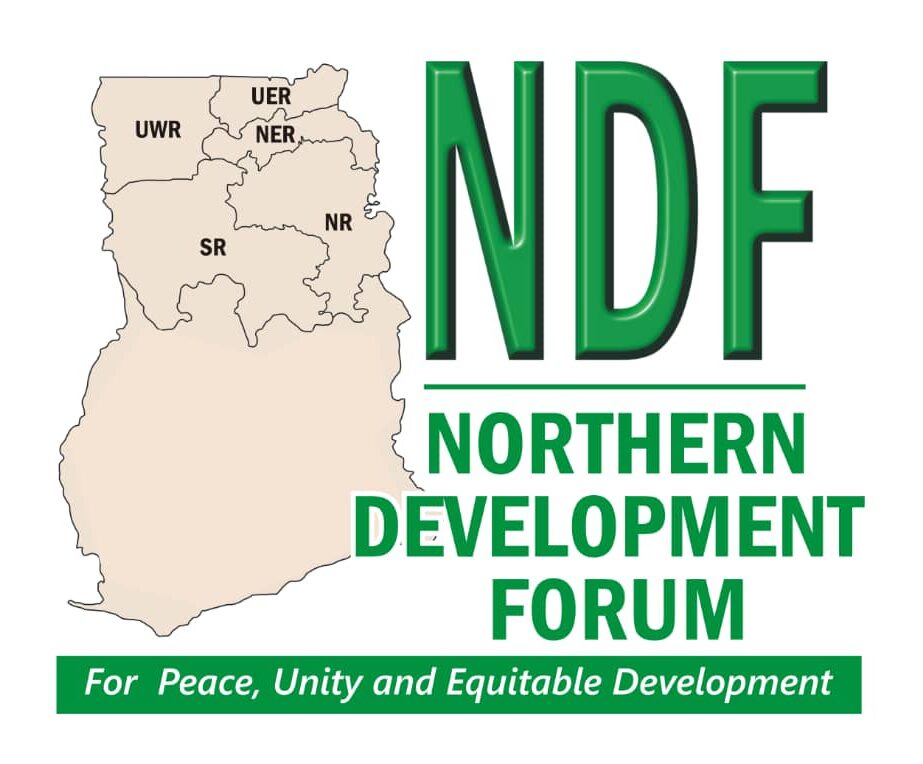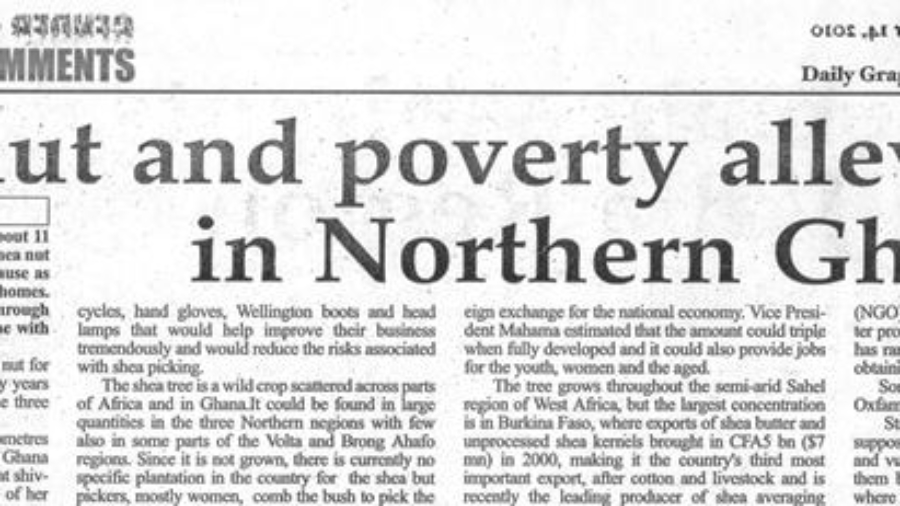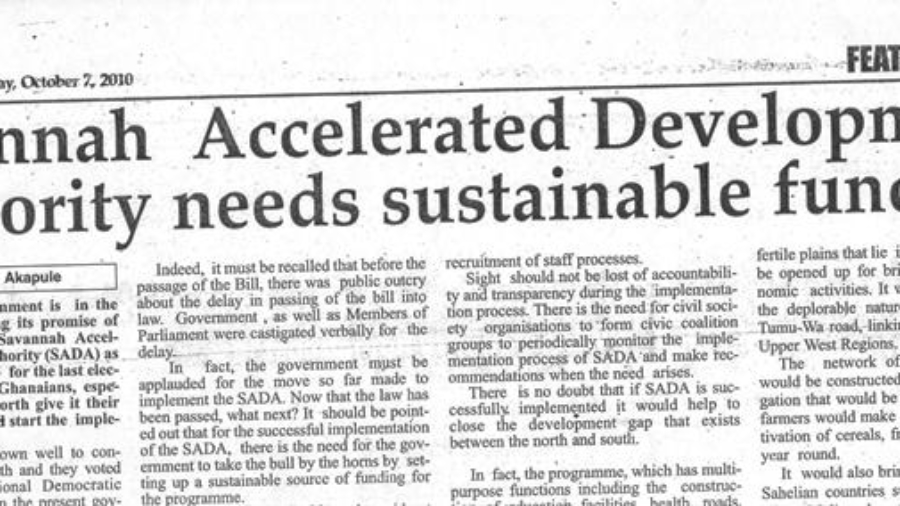DAILY GRAPHIC
THURSDAY, OCTOBER 14, 2010
SHEA NUT AND POVERTY ALLEVIATION IN NORTHERN GHANA
STORY BY: PAUL ACHONGO KWODE
Felecia Kawe (pseudonym) was about 11 years of age when she died through shea nut picking. She did not die a natural cause as is the case in most traditional Ghanaian homes. Kawe died stragely on May 16, 2010 through snake bite in the bush where she had gone with friends at dawn to bring home shea nuts.
Her family of four depended on the shea nut for their daily living since their father died many years ago leaving the blind mother to bring up the three children alone.
Manyoro is a village of about 53 kilometres from Nanvrongo is the Upper East Region of Ghana where she lived. The death of Kawe sent great shivering throughout the village not only because of her death, but rather how the family was going to cope since she was the bread winner of the family.
Their dependence on the shea nut for their daily living occurs mostly at the peak of the shea season during the months of April-August. They did not only depend on it for only their breakfast but lunch and supper.
Her death illustrate a clear case of high risks associated with shea nut picking. Kawe’s tragic death is only one out of many who die during shea picking. Most of the shea nut pickers across the shea producing parts of the country do not have any protective clothing, Wellington boots, hand gloves and this exposes them to harmful creatures and the weather.
The conditions shea nut pickers go through before picking the nuts are too dangerous. The pickers have on countless occasions complained and appealed to the government and civil society and NGO’s to assist them with protective kits.
Some of their complaints include being bitten by snakes because they use their bare hands and sometimes bare feet to comb the bush in search of the nut.
Madam Abdulai Zuwera of the Tungteiya Shea Butter Extraction Women Association of Gushiegu told this writer that “It is out of the nut that we make our daily living and support our children in schools and if the business is left to collapse, where will our future be?”
Madam Zuwera said she would be grateful if members of the association were assisted with tricycles, hand gloves, Wellington boots and head lamps that would help improve their business tremendously and would reduce the risks associated with shea picking.
The shea tree is a wild crop scattered across parts of Africa and in Ghana. It could be found in large quantities in the three Northern regions with few also in some parts of the Volta and Brong Ahafo regions. Since it is not grown, there is currently no specific plantation in the country for the shea but pickers, mostly women, comb the bush to pick the nut. Such a practice results in a large proportion of the nuts being lost.
Shea is often referred to as “Life” especially in Dioula language in Burkina Faso and where it is also generally grown wild, with little need for any speial cultivation or nourishment. There are a few plantations of the crop in Burkina Faso. In Burkina Faso, it is called “women’s gold.”
Almost all parts of the tree have some practical use. The bark is an ingredient in traditional medicines against certain childhood ailments and minor bruises and cuts. The shell of the nuts can repel mosquitoes.
Above all, the fruity part of the nut, when crushed, yields a vegetable oil that could be used in cooking, soap-making and for skin and hair care. Harvesting the nuts and making the butter have traditionally been women’s work. Men usually are involved only in its transportation and marketing.
The cash crop shea is also valuable for the treatment of certain diseases by herbalists. It also offers employment for several individuals who take part in all of its value chain processes. According to the Vice President of Ghana, John Dramani Mahama, more than 900,000 women in the three Northern regions, collect over 130,000 tonnes of dry nuts annually. The industry also benefits close to two million poor people, about 95 per cent of whom are rural households, though its full potential is yet to be exploited. The infant industry is an attractive business venture earning about 30 million dollars of foreign exchange for the national economy, Vice President Mahama estimated that the amount could triple when fully developed and it could also provide jobs for the youth, women and the aged.
The tree grows throughout the semi-arid Sahel region of West Africa, but the largest concentration is in Burkina Faso, where exports of shea butter and unprocessed shea kernels brought in CFA5 bn ($7mn) in 2000, making it the country’s third most important export, after cotton and livestock and is recently the leading producer of shea averaging 50,000Mt while Ghana follows second with production of 45,000MT per annum.
It was therefore heartwarming when Dr. Joshua Yidana, Head of the Horticultural Department of the University for Development Studies (UDS) told this writer that he had been experimenting with the shea tree through grafting propagation.
According to him, the method had proved that the shea tree, through grafting, could bear fruit in a gestation period of between three to six years. He said the research was a breakthrough and if successfully implemented could reduce the gestation period of the crop from 10-15 years to between three to six years and therefore increase production of its products.
The findings are intended to enable farmers and the government to grow the crop just as it is with cocoa.
DR. Yidana said the first ever grafting of the shea nut was successful in 2008 and that he was studying the grafting method at Zoonaaliyi near Nyakpala where about 1,200 grafted plants covering about a hectare of land was being observed. Dr. Yidana’s experiments just like any other academic work have generated heated debates in the academic circles particularly from the Cocoa Research Institute of Ghana (CRIG) which expressed doubt about the findings.
According to them, they had been making several studies on the plant especially on its gestation period but were yet to come to such conclusions.
A lot of Non-Governmental Organization (NGO) have shown interest in promoting shea butter production and marketing in Ghana and support had ranged from linkages to markets, assistance on obtaining technology and training in business skills.
Some of these NGO’s are Send Ghana, SNV, Oxfam, GTZ.
Strangely enough, some of these NGO’s which supposedly aims at protecting the interest of the poor and vulnerable in the shea industry turn to exploit them by setting up some shea processing centres where women pick and process the shea. The poor and vulnerable are usually cheated at the point of purchase as their products are bought cheaply by some of these NGO’s.
Another point of cheating is through the value chain as the companies in the shea industry make huge profits at the expense of the poor.
Some of the NGOs also give loans or credits to these vulnerable farmers in the shea sector with huge interest rates. It is however that the NGOs advocate the best for the shea industry but the interest of the vulnerable farmers must be paramount else they may be using the poor farmers to fight for their own interest. Some of the interventions of some NGOs must however be lauded.
It appears that the shea industry faces numerous challenges which are surmountable. Some other challenges the shea industry is faced with include uncontrolled pricing both locally and internationally, inadequate information of the crop due to limited research, bush burning, loss of shea tree through cutting the trees for charcoal and a host of other problems that needs to be addressed to pave way for more investment with great dividend for the shea industry.
The intervention will not only alleviate poverty through job creation but also contribute to meeting the Millennium Development Goal of reducing poverty as well as enhancing the socio-economic fortune of the country.
There seem to be hope for the shea industry with the ongoing implementation of the Savannah Accelerated Development Authority (SADA).
SAVANNAH ACCELERATED DEVELOPMENT AUTHORITY NEEDS SUSTAINABLE FUNDING
DAILY GRAPHIC
THURSDAY 7 OCTOBER, 2010
SAVANNAH ACCELERATED DEVELOPMENT AUTHORITY NEEDS SUSTAINABLE FUNDING
STORY BY: Samuel Adadi Akapule
The current government is in the process of fulfilling its promise of implementing the Savannah Accelerated Development Authority (SADA) as captured in its manifesto for the last election campaign, that if Ghanaians, especially those from the north it their mandate to rule, it will start the implementation of SADA.
The message went down well to convince people of the north and they voted massively for the National Democratic Congress (NDC) to form the present government.
However, when the government came into power and had not implemented the SADA, many people from the northern parts of the country were becoming impatient and disillusioned. Civil society organization such as SEND Ghana and the Integrated Social Development Center (ISODEC) emerged vigorously with advocacy reminding the government of its promise to implement SADA.
At one of such advocacy forums organized by SEND Ghana in Bulgatanga in the Upper East Region. Participants advocated strongly that it was time the Bill, which was before parliament was passed into law to facilitate the implementation process.
When parliament in August 2010 passed the Bill into law and received the president’s signature in September 2010, it attracted a lot of commendation from the people, especially those of northern descent. Bodies from the northern parts of the country including the Northern Development Forum (NDF) paid great tribute to the government for the passage of the law.
Indeed, it must be recalled that before the passage of the Bill, there was public outcry about the delay in passing of the bill into law. Governments, as well as Members of Parliament were castigated verbally for the delay.
In fact, the government must be applauded for the move so far made to implement the SADA. Now that the law has been passed, what next? It should be pointed out that for the successful implementation of the SADA, there is the need for the government to take the bull by the horn by setting a sustainable source of funding for the programme.
It must be emphasized here that without a sustainable funding component, implementation of SADA would stall and this would have dire consequences on the NDC during Election 2012.
The funding should be donor driving else it will defeat the purpose of establishing SADA. At a forum a forum organized inn Bolgatanga by SEND Ghana; participants stressed the need for the government to set up a special tax system to attract sustainable funding for the implementation process.
It is very crucial for the government to consider the views expressed by the participants at the forum to ensure the successful implementation of SADA.
Other civil society organizations including NDF; ISODEC; Foundation for Grass Roots Initiatives in Africa have expressed similar views of establishing sustainable funding for the programme.
Again, the recruitment process into the programme should be based on competence, devoid of ethnicity, political and religious grounds. Dedication and honesty should also be important determination factors in the recruitment of staff processes.
Sight should not be lost of accountability and transparency during the implementation process. There is the need for civil society to organization to form civic coalition to periodically monitor the implementation processes of SADA and make recommendations when the need arises.
There is no doubt that if SADA is successfully implemented it will help to close the development gap that exist between the north and south.
In fact, the programme, which has multi-purpose functions including the construction of educational facilities, health, road; agriculture among other things, would in no doubt reduce poverty in the area and curb the current rural urban drift.
Let the government show more commitment to the implementation processes. A successful implementation of the programme would give it much credibility since it will go down well in the history books of Ghana for posterity to see that it was the only government that could turn out a feasible to bridge the north-south development gap.
The projects coverage areas in the three Northern Regions are the Northern, Upper East and Upper West and also the savannah areas of the Brong-Ahafo and parts of the Volta Region. It is expected that when the programme is given special attention, it would help to reduce poverty and facilitate adaptation to climatic changes and ecological transformation of northern Ghana.
It will create a circular road network that would connect the Upper West, Upper East and Northern Regions such that large fertile plains that lie in these regions, would be opened up for brisk farming and economic activities. It will help to improve the durable nature of the Navrongo-Tumu- Wa road, linking the Upper East and Upper West Regions.
The network of drainage canals that would be constructed to facilitate drip irrigation that would be owned by smallholder farmers would make it possible for the cultivation of cereals, fruits and vegetables all year round.
It would also bring strong linkage with Sahelian countries such as Burkina Faso, Niger, Mali and northern cote d’Ivoire and this would open up a true regional market for goods and services, with northern Ghana as a competitive supply and industrial hub. It must be pointed out that the attempt at bridging the north and south development gap has been a long standing dream of many post-independent government of Ghana. There had been previous attempt – Northern Region Rural Integrated Project (NORRIP); Irrigation Company of Upper Region (ICOUR); Land Conservation and Small-Holder Rehabilitation Project (LACOSREP) and Farmer’s Services Company (FASCOM) – but all this failed to make the desired impact because of mismanagement. It is the hope of this writer that SADA would not go the way of its predecessors.


